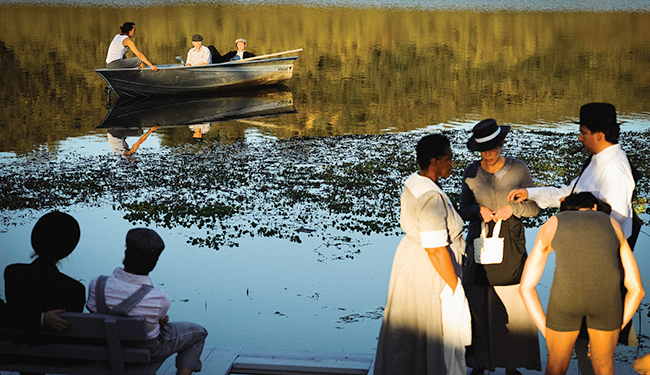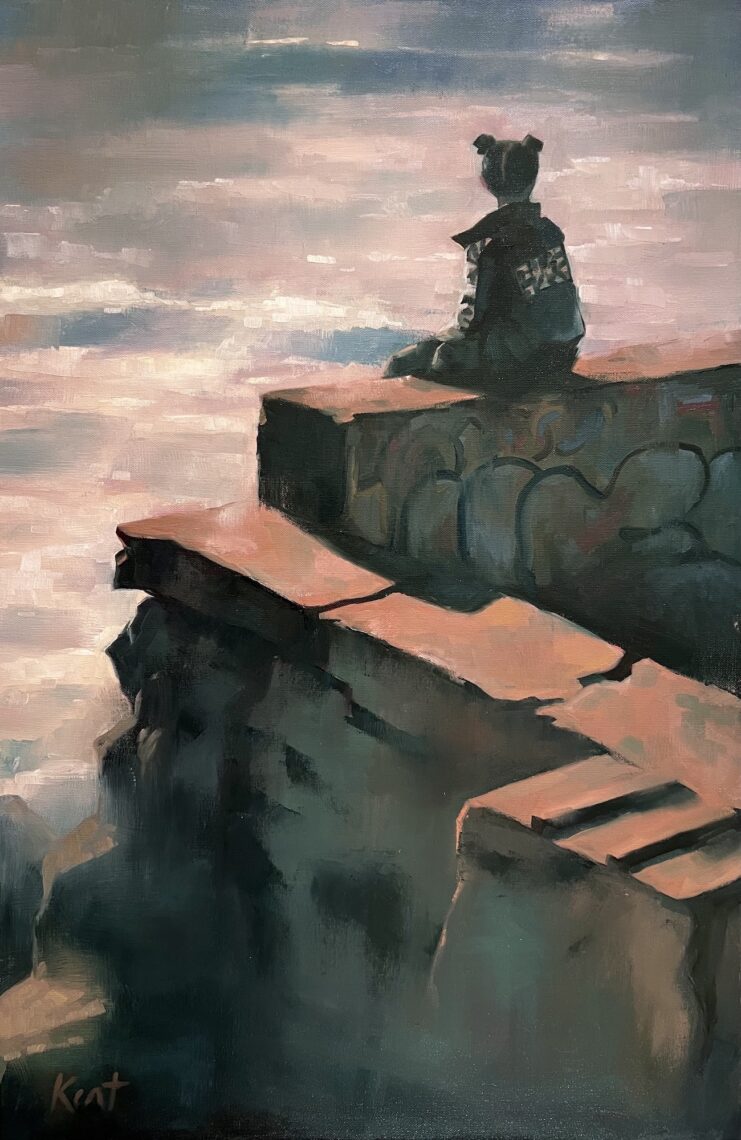
Artist takes performance to new heights at Stanford biological preserve
Visiting artist Ann Carlson brings her background in dance, choreography, theater, visual art and performance art to an unlikely stage – Jasper Ridge Biological Preserve in the eastern foothills of the Santa Cruz Mountains.
Visiting artist Ann Carlson is no stranger to unconventional performance sites, including frozen ponds, dairy farms and trains.
But her latest project took her to new heights: Stanford’s biological preserve in the eastern foothills of the Santa Cruz Mountains.
“Picture Jasper Ridge is a way to connect to the history that we stand on. It’s an invitation to realize that every moment is part of a continuum of other moments, past and future,” said Carlson, an award-winning performer.
Over the course of three days earlier this month, ticket holders were bused from the Stanford campus to Jasper Ridge Biological Preserve (JRBP) for a 70-minute silent hike to experience the beauty and environmental diversity of the preserve. They also saw nine archival photographs recreated by actors – tableau vivant-style – on or near the spot where the photograph was originally taken.

Toni Gauthier
“It’s a performance hike that is meant to be an exhilarating window into the heart of this land and its impact,” Carlson said.
The new work is a product of Carlson’s yearlong association with the Drama Department at Stanford that includes teaching a drama class in the fall and being appointed the preserve’s visiting artist.
An unlikely stage
When the preserve’s director, Philippe Cohen, approached the Stanford Arts Institute about engaging the first visiting artist at the preserve, program director Sarah Curran responded enthusiastically with the perfect artist match.
“I think Philippe thought we’d end up with a photographer or landscape artist,” she said. “But I remember sitting at that table, and I knew Ann would be the right choice.”
Curran said the JRBP visiting artist needed to be a deep thinker, someone who could reach across disciplines, and someone who would actively engage with the campus.
“Ann opened up the gateways between the arts, sciences and history, and invited active participation from all parts of campus,” Curran said.
For this project-based, site-specific work, Carlson spent months researching and collecting archival photographs shot at Jasper Ridge dating back to the 1890s. Next, she assembled a production team and enlisted a cast of actors to recreate nine photographs in color or gray scale.
The en plein air project involved more than 60 performers, 15 docents, scores of community members, historians, biologists, geologists, archaeologists, students and professors.
What they saw
Audience members described the performance hike as moving, meditative and, in the case of Charles Junkerman, “one of the most extraordinary experiences I’ve ever had.”
Junkerman, the associate provost and dean of Stanford’s continuing studies, confessed that he didn’t know what to expect.
“I was surprised by how emotional my reactions were. The actors in the tableaux vivants, after all, are representing people who were once here and are gone, so I felt a kind of elegiac sadness at their absence,” he said. “But the actors are present, and are recalling the absent ones, which is life-affirmative, but also kind of scary. I actually felt shivers at a few of the stations.”
Junkerman attended the hike with his wife, son and daughter. He said the experience was “totally captivating, stimulating, and provocative.”
“We talked and talked about it right through dinner and into the evening,” he added.
Artist explores stillness and silence
Carlson defines dance as any conscious movement in time and space. She considers the stillness of tableau vivant a part of the continuum of motion.
“It’s such a gift – the performer taking up stillness,” said Carlson. “In viewing the still yet energized body, there is an exciting – almost intoxicating – opportunity to see the motion of the world within which that body resides. Working with stillness is perhaps a way to underscore the present moment even more.”
Just as stillness can define movement, silence can emphasize sound.
Carlson’s instruction that the hike be conducted in silence allowed the sounds of birds, squirrels, footfalls and breathing to take over as an unusual soundtrack. Audience members told Carlson they were grateful for the silence.
The preserve
For Cohen, Picture Jasper Ridge was a collaboration that not only fulfilled Carlson’s artistic intent, but also advanced the mission of the preserve.
“Part of our mission is to conserve resources, and I consider our past a part of the resources we preserve. Ann’s effort helps maintain our awareness of historical resources we might otherwise lose track of or underappreciate,” Cohen said.
He also was excited by the prospective benefits of interdisciplinary cooperation.
“Picture Jasper Ridge is about the bringing together of different types of creative energy and impulses and seeing what new horizons are revealed,” he said.
The preserve, not far from Stanford’s campus, encompasses remarkable geological, topographic and biotic diversity within its 1,189 acres and provides a natural laboratory for researchers from all over the world.
The field station also provides educational experiences for Stanford undergraduates and students from other colleges and universities, and plays an active role in educating the general public.
Limited preserve tours are conducted for individuals and groups who are closely aligned with the mission of contributing to the understanding of the earth’s natural systems through research, education and protection of the preserve’s resources.






















